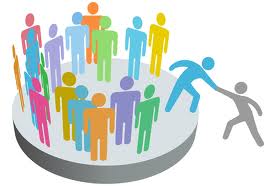Leading Teams and groups
This article gives some theory behind group dynamics and the different behaviours you may observe within one group. There is a lot more practical and theoretical information in Teams and groups section.
Overview
 As a Leader you ideally want a balanced team, so it is worth taking some time to observe your team and see where individuals sit in the group dynamics. You may observe areas of behaviour that negatively impact your team, which you can then address. Alternatively, you may observe positive behaviours that you would like to encourage. Understanding your team is a step to developing an effective group.
As a Leader you ideally want a balanced team, so it is worth taking some time to observe your team and see where individuals sit in the group dynamics. You may observe areas of behaviour that negatively impact your team, which you can then address. Alternatively, you may observe positive behaviours that you would like to encourage. Understanding your team is a step to developing an effective group.
In all human interactions there are 2 major ingredients – content and process.
The first deals with the subject matter or task, and the second is concerned with what is happening between and to group members. Group dynamics deals with such things as:
- Morale
- Feeling tone
- Atmosphere
- Influence
- Participation
- Styles of influence
- Leadership struggles
- Conflict
- Competition
- Cooperation, etc
These things can influence the effectiveness, or otherwise of a group. These processes are present in all groups, and awareness of them will enhance a person’s worth to the group and enable him/her to be a more effective group participant.
Participation
This is mostly related to verbal participation –
- Who are the high participators?
- Who are the low participators?
- Do you see any shift in participation – highs become quiet, lows suddenly become talkative. Do you see any possible reason for this in the group’s interaction?
- How are the silent people treated? How is silence interpreted? Consent? Disagreement? Disinterest? Fear? Power?
- Who talks to whom? Do you see any reason for this in the group’s interactions?
- Who keeps the ball rolling? For what purpose?
Influence
Influence and participation are not the same thing. Some people may speak little yet capture the attention of the group. Others may talk a lot but are not generally listened to by other members.
- Which members are high in influence? This is, when they talk, others seem to listen.
- Which members are low in influence? Others do not listen to or follow them. Is there any shifting in influence? Who shifts?
 Influence can take many forms. It can be positive or negative. It can enlist the support or cooperation of others or alienate them. How a person attempts to influence another may be the crucial factor in determining how open or closed the others will be towards being influenced. These are suggestive of 4 styles that frequently emerge in group:
Influence can take many forms. It can be positive or negative. It can enlist the support or cooperation of others or alienate them. How a person attempts to influence another may be the crucial factor in determining how open or closed the others will be towards being influenced. These are suggestive of 4 styles that frequently emerge in group:
- Autocratic – does anyone impose their will or values on other group members or tries to push them to support his/her decisions? Who evaluates or passes judgment on other group members? Do any members block action when it is not moving the direction they desire? Who pushes them to ‘get the group organised’?
- Peacemaker – who eagerly supports other group members’ decisions? Does anyone consistently try to avoid conflict or unpleasant feelings from being expressed by pouring oil on troubled waters? Is any member typically deferential towards other group members? Gives them the power? Do any members appear to avoid giving negative feedback ie who will say anything only when it is positive feedback?
- Laissez Faire – are any group members getting attention by their apparent lack of involvement in the group? Does any group member go along with group decisions without seeming to commit him/herself one way or another? Who seems to be withdrawn and uninvolved? Who does not initiate activity, only participates ‘mechanically’ and in response to another?
- Democratic – does any try to include everyone in all group decisions or discussions? Who expresses his/her feelings and opinions openly and directly without evaluation or judging others? Who appears to be open to feedback and criticism from others? When feelings run high, and tension mounts, which members attempt to deal wit the conflict in a problem-solving way?
Decision making procedures
Many kinds of decisions are made in groups without considering the effects of these decisions on other members. Some people try to impose their own decisions on the group, while others want all members to participate or share in decision that are made.
- Does anyone make a decision and carry it out without checking with other group members? (self-authorised), for example a topic of discussion, and how does this effect the group?
- Does the group drift from topic to topic? Who topic-jumps and what might the purpose be?
- Who supports other members/ suggestions or decisions? Does this support result in the two members deciding on the topic or activity for the group – and how this might affect other group members.
- Is there evidence of majority pushing a decision through over other members’ objections?
- Is there any attempt to get all members participating in a decision (consensus)? What effect does this seem to have on the group?
- Does anyone make any contributions which do not receive any kind of response or recognition? What effect does this have on the member?
Task Functions
These functions illustrate behaviours that are concerned with getting the job done or accomplishing the group tasks.
- Does anyone ask for or make suggestions as to the best way to proceed or to tackle the problem?
- Does anyone attempt to summarise what has been covered or what has been going on in the group?
- Is there any giving or asking for facts, ideas, opinions, feelings, feedback or searching for alternatives?
- Who keeps the group on target? Who prevents topic-jumping or going off on tangents?
Maintenance Functions
These functions are important to the morale of the group. They maintain good and harmonious working relationships among members and create a group atmosphere which enables each member to contribute maximally. They ensure smooth and efficient teamwork with the group.
- Who helps others get into the discussion (gate openers)?
- Who cuts off others or interrupts them (gate closers)?
- How well are members getting their ideas across? Are some members preoccupied and not listening? Are there any attempts by group members to help others clarify their ideas?
- How are ideas rejected? How do members react when their ideas are not accepted? Do members attempt to support others when they reject their ideas?
Group Atmosphere
Something about the way a group works creates an atmosphere which in turn is revealed in a general impression. In addition, people may differ in the kind of atmosphere they like in a group. Insight can be gained into the atmosphere characteristic of a group by finding words which describe the general impressions held by group members:
- Who seems to prefer a friendly, congenial atmosphere? Is there any attempt to suppress conflict?
- Who seems to prefer an atmosphere of conflict? Do any members provoke or annoy others?
- Do people seem involved and interested? Is the atmosphere on of work, play, satisfaction, taking flight, sluggishness etc?
Membership
 A major concern for group members is the degree of acceptance or inclusion in the group. Different patterns of interaction may develop in the group which give clues to the degree and kind of membership:
A major concern for group members is the degree of acceptance or inclusion in the group. Different patterns of interaction may develop in the group which give clues to the degree and kind of membership:
- Is there any sub grouping?
- Do some people seem ‘outside’ the group (lean backwards in their chairs)? Are there some who are ‘in’ and how are the ‘outside’ treated?
- Do some members move in and out of the group? Under what conditions do they move?
Feelings
During any group discussion, feelings are frequently generated by interactions between members. These feelings are seldom talked about.
- What signs of feelings do you observe in group members: anger, irritation, frustration, warmth, affection, excitement, boredom, defensiveness, competitiveness etc?
- Do you see any attempts by group members to block the expression of feelings, particularly negative feelings? How is this done? Does anyone do this consistently?
Norms
Standards or ground rules may develop in a group that control the behaviour of its members. Norms usually express the belief or desires of the majority as to what behaviours should or should not take place. These norms may be clear to all members (explicit), known or sensed by only a few (implicit), or operating completely below the level of awareness of any group members. Some norms facilitate group process and some hinder it.
- Are certain areas avoided in the group (sex, religion, feelings, the leader)? Who seems to reinforce this avoidance, and how do they do it?
- Are group members overly nice or polite to each other? Are only positive feelings express? Do members agree with each other too readily? What happens when members disagree?
- Do you see norms operating about participation or the kinds of questions that are allowed (if I talk, you must talk)? Do members feel free to probe each other about their feelings? Do questions tend to be restricted to intellectual topics or events outside the group?